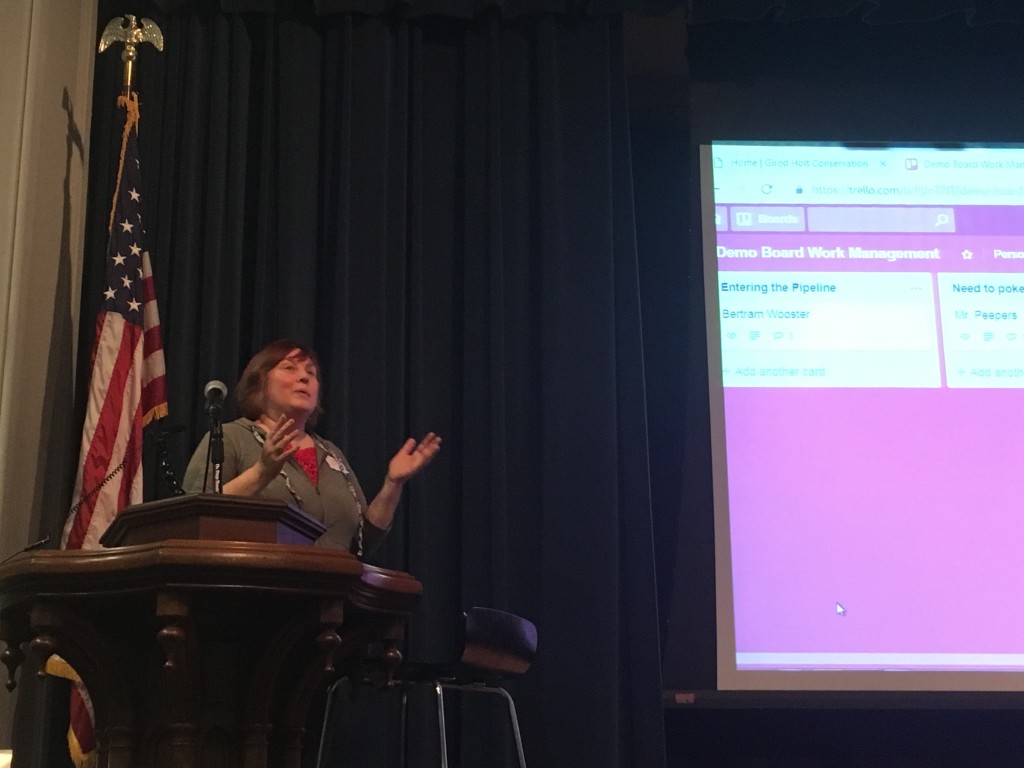Washington Conservation Guild’s April Meeting: Tips and Lessons Learned Session at the African American Civil War Memorial Museum
Speakers:
- Boyoung Lee, Post-doctoral Research Fellow, Museum Conservation Institute, Smithsonian Institution on behalf of Mary Ballard, Senior Textile Conservator, Museum Conservation Institute, Smithsonian Institution
- Samantha Owens, Conservation Fellow, Glenstone Museum
- Steven Pickman, Steven Pickman Objects Conservation
- Diana Galante, Conservator in Private Practice
- Rachel Greenberg, Objects Conservator, National Air and Space Museum, Smithsonian Institution
- Jayne Girod Holt, Girod Holt Conservation, LLC
- Ariel O’Connor, Objects Conservator, Smithsonian American Art Museum, Smithsonian Institution
Attendance: (approximately) 30 people

For the first time, the Washington Conservation Guild dedicated a session to the sharing of tips and lessons learned amongst members. The breadth of topics covered ran the gamut of concerns related to exhibitions and display, treatment approaches, and more efficient project management.
Boyoung Lee presented on behalf of Mary Ballard, discussing alternative strategies to evaluate materials used in collections care, particularly for exhibition and storage. While more rigorous testing protocols exist, they typically require a longer time for evaluation as well. Ballard suggests considering the material and the context it will be used in as a quick way of determining its suitability for use. Moreover, one can think about its solvency or reactivity as well as a quick indicator of whether certain materials may pose issues.
Samantha Owens discussed an ongoing conundrum with regards to developing a strategy to address damages to weathering steel outdoor sculptures as a result of visitor activity. Graffiti in the form of burnished marks on the protective corrosion layer of weathering steel is difficult to reduce, and the corrosion layer cannot be easily and sustainably regenerated. Owens described the need for a passive solution as limitations to staffing preclude active monitoring by museum security.
Ariel O’Connor described the use of Rhoplex N580 adhesive “dots” instead of museum wax to secure objects on clear (glass) display shelves unobtrusively. The solution is a temporary one given that the adhesive is known to be prone to yellowing within a year, but has its utility in time-limited displays.
Steven Pickman shared two tips from a recent workshop given by Steven Koob on ceramics and glass restoration. The first involves the use of dental wax sheets with adhesive backings for the casting of fills in situ; the backing adheres well to surfaces and provides a good seal that eliminates the need to fuss with dental wax sheets for it to do the same. The second tip takes advantage of the thermoplastic properties of thin sheets of cured epoxy resin by manipulating them for fill applications above their glass transition temperature.
Diana Galante introduced solutions devised for the cleaning of scientific glassware at the National Museum of American History, which had inner spaces that were difficult to access using conventional cleaning methods. Galante discussed several innovative options, from modifying test tube cleaners, to the use of paired rare earth magnets (wrapped or sewn into sleeves to prevent scratching), and swirling glass beads or steel shot for slight abrasive action (the latter tip courtesy of Ainslie Harrison and Beth Richwine). Using twill tape or an absorbent material to wrap the rare earth magnets also allows the use of solvents to aid in cleaning.
Rachel Greenberg described experiments to find a visually convincing and stable material to replace completely degraded polyurethane foam components in objects for display. Their open pore structure makes it difficult to find a fitting alternative, but Greenberg found success at using nylon stockings wrapped around polyester batting. The stockings can be dyed/colored to match the desired tone as needed.
Jayne Girod Holt gave a brief primer on the use of the software platform Trello for project management. Holt demonstrated how sample workflows in a private practice can be better managed and showed how easy it was to keep track of clients, projects, records using the platform. Audience members also pitched in with the ease with which Trello can be integrated into other productivity applications.
Summarized by Soon Kai Poh, Graduate Intern at the Freer Gallery of Art and Arthur M. Sackler Gallery, Smithsonian Institution, and Fourth-Year Graduate Student, Conservation Center, Institute of Fine Arts, NYU